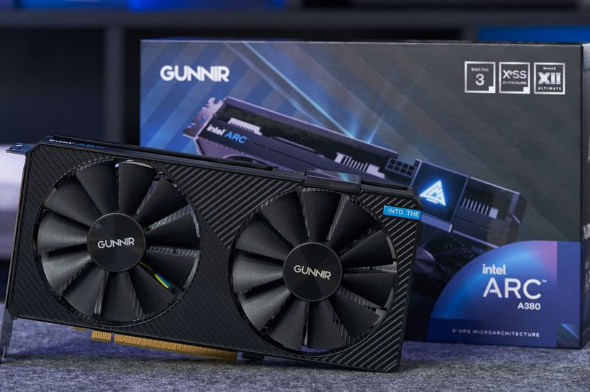Connection to DriversCloud Create a DriversCloud.com account Reset your DriversCloud.com password Account migration
Arc Alchemist: Intel between disappointments and hopes of mini-PC dedicated to video games
The least we can say is that for its return to the graphics card market, Intel is blowing hot and cold.
A few weeks after making official the release of the first Arc Alchemist models - its new graphics solutions - for laptops, Intel has finally released the first desktop versions of its cards on the market (Chinese for the moment). A certain Shenmedounengce, a user of the Bili Bili platform, is one of the first to get his hands on one of these cards and he is in any case the first to publish an independent test. This is an opportunity to see what this Intel GPU has in its belly.
Unfortunately, as reported by Videocardz, the results are "mixed" to avoid using a more derogatory term. Shenmedounengce was able to compare the Intel Arc A380 to several graphics solutions: the AMD RX 6400 and RX 6500XT as well as the NVIDIA GTX 1650 and RTX 3050. To do this, he used the same platform: a machine based on a B660 motherboard on which was mounted an Alder Lake Core i5-12400 processor. Unfortunately, we have no details of the drivers used and the amount of RAM on board.
Nevertheless, the results are not pretty for Intel. Indeed, if the beginnings were interesting on the Port Royal and TimeSpy stages of 3DMark - the A380 is simply ahead of the RTX 3050 - things get complicated as soon as we move on to the FireStrike stage of the same 3DMark: there, the A380 simply beats the modest GTX 1650. Even worse, in games, the A380 can't even outperform the little NVIDIA card, and whether it's League of Legends, Grand Theft Auto 5, PUBG, Shadow of The Tomb Raider, Forza Horizon 5 or Red Dead Redemption 2, it always finishes in last place.
It's important to note, however, that Intel insists on enabling Resizable-BAR for its Arc Alchemist solutions: we don't know if it was done for these tests. Furthermore, the A380 is clearly the least powerful of Intel's planned desktop graphics solutions. We can logically hope that the stronger models (A550 / A770) will be able to do better against the competition. This is also to be hoped for Intel, which recently presented its Serpent Canyon NUC, which is based on an Arc Alchemist A770M GPU.
Serpent Canyon will be the next generation of Intel's NUCs, which are extremely compact but powerful enough to do "everything like a big one". For this, Intel has turned to its 12th generation processors, in this case a Core i7-12700H with 14 cores. It will be supported in its task by an Arc Alchemist A770M GPU with 32 Xe-Cores and complemented by 16 GB of GDDR6. Despite its small size, the Serpent Canyon has extensive connectivity with, on the front, an SDXC card reader, a Thunderbolt 4 port, a USB-A 3.2 connector and an audio jack. On the back, there are four USB-A ports, an RJ45 2.5 GbE, a Thunderbolt 4 port as well as a DisplayPort and an HDMI port. It remains now to know the performance of the beast and, of course, to have an idea of the release date / selling price envisaged by Intel.







